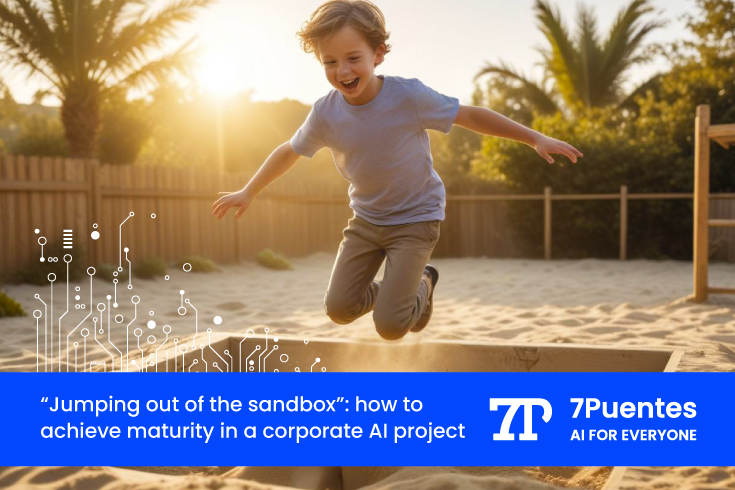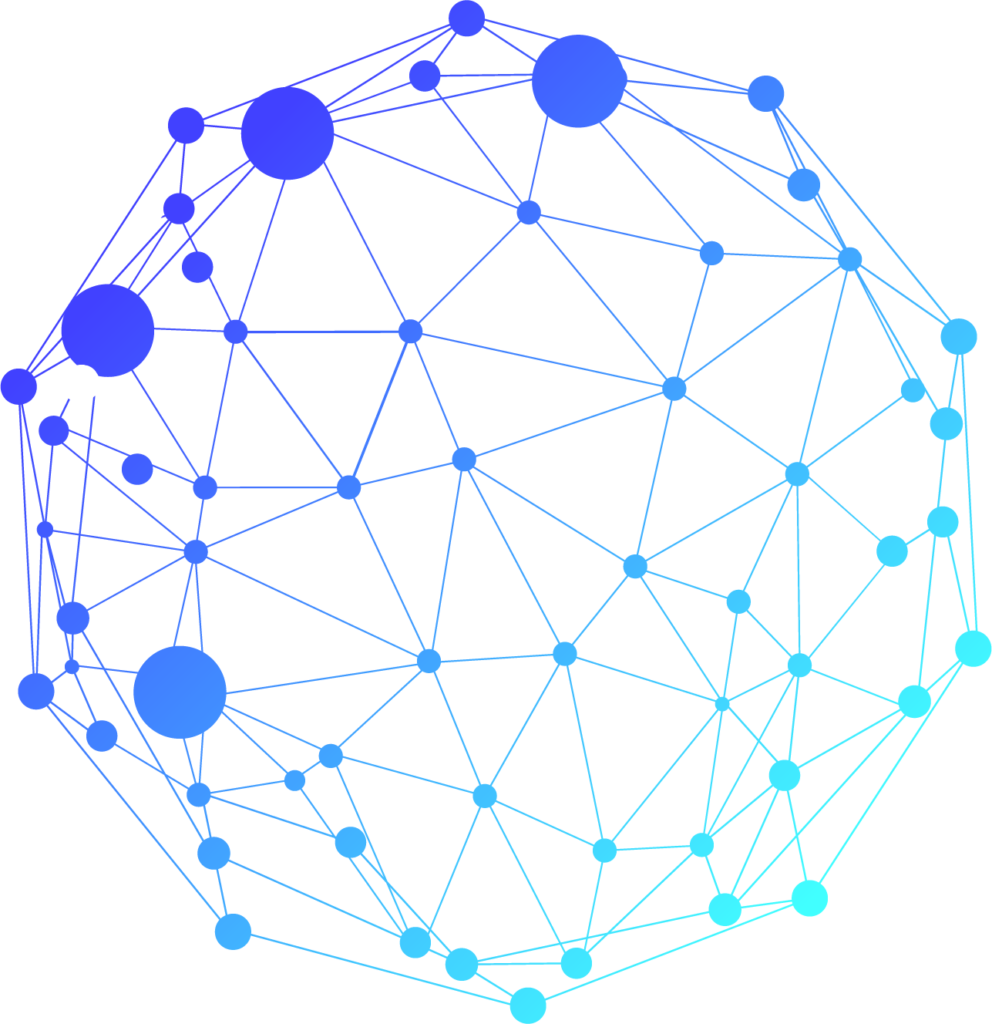In more than 15 years of managing projects for all types of organizations in all industries, we have found a common problem: the lack of maturity of several corporate ai projects and data science initiatives to achieve an efficient, robust and integrated implementation, remaining only a simple proof of concept (PoC). In this post, we will share our perspective on the problem and possible courses of action to help an organization get out of the sandbox.
At 7Puentes, we have decades of experience managing innovative projects in Artificial Intelligence (AI), Machine Learning (ML), and Data Science (DS). Over the years, we have observed a common problem in AI implementation projects in companies: the need to get out of the sandbox, the playground, to stop playing with data and start building Proofs of Concept (PoC) that manage to emerge into the reality of the market, that is, its implementation.
It’s clear that if companies don’t have a robust AI strategy in place, doing a PoC is often beyond them and is a problem in itself.
First, the organization as a whole has to agree that AI and data are worthwhile and that it is a new technology that needs to be prioritized both strategically and operationally. In practice, however, this does not usually happen, and these small proofs of concept are assembled with data that is poorly curated, not clean or well organized, and with goals that are not entirely clear because they are poorly measurable. In short, the organization is not ready to face this process of change.
Second, there is no clear road map or vision of where you want to go. That’s where the metaphor of leaving the sandbox (the illustration on the cover of this post) comes from with a child jumping out of the playground sandbox: it’s time to grow, mature, and make responsible decisions in projects with a data-driven strategy. And this would be the key.
Ongoing tension between business and IT
It is a truism that in order to get out of the sandbox, you must first break the existing tension between business and IT, which is the first initial problem we see in organizations. The business knows the situation, and the IT knows the systems, but the two are not in sync. So if the member of the company who is driving the project is from IT, the business support is complicated, while if the person driving the project is from the business, it ends up as a proof of concept that is completely disconnected from the rest of the organization.
Sometimes the goals are disconnected: the business wants to make more money for the company and be sustainable, they are not interested in the software, and the IT wants to make sure there are no technical problems to exploit and that there is no additional inconvenience in the process, but they are not too interested in the business. However, each area is unaware that it needs the other to survive and the project to succeed.
In this constant tension, IT people usually don’t understand much about business, and business people don’t understand how to build software, so we have to try to resolve it. Both parts of the company need to have the dialogue and empathy to put the problem on the table.
Our career at 7Puentes, as consultants we have found ourselves in the middle of this problem, being a bridge or a mediator: the real job ended up being to help resolve this friction that exists between areas, sometimes we end up in the middle of the business area and sometimes in the middle of the IT area. We had to try to understand that friction or that conflict and try to contribute so that the organization is one with the same project and the same direction. We can say that every time we intervene in this matter, we come to a good conclusion
How do you make sure that the PoC does not just remain a PoC and is brought to the level of efficient implementation?
What is the importance of developing a proof of concept in the context of an AI project?
1. Viability: When the organization innovates in AI and data science, today it does not know if the model will work. Hence the importance of the PoC: to see if it will work and if it is feasible in our organization, it needs to be executed.
2. Maturity stage: Once the PoC is solved, it needs to be matured. However, this often requires profound changes in the organization to be able to implement it. This is where the company’s true limitations become apparent:
- There is no integration of business units to bring the PoC to a new level of maturity.
- Your company cannot do a PoC because it does not have a data lake. Or you don’t have the labeled and trained data sets that we will use in the real world.
- You do a simple proof of concept because the budget is limited and you do not have enough support to give 10 times the budget, and you have to fix it that way.
- Need for executive support: Even though companies have skilled data scientists, AI projects often remain in PoCs that are not mature. And there are still tensions between departments. Sometimes budgets are requested to run 10 projects and only 1 is completed. Of course, if the models were left in a state of limbo, there would be no management support. So the challenge is to make the qualitative leap to reverse this situation.
3. Need for executive support: Even though companies have skilled data scientists, AI projects often remain in PoCs that are not mature. And there are still tensions between departments. Sometimes budgets are requested to run 10 projects and only 1 is completed. Of course, if the models were left in a state of limbo, there would be no management support. So the challenge is to make the qualitative leap to reverse this situation.
The need for an organizational diagnosis of where we stand
Most organizations will face this problem at some point in their history. What they need is a diagnosis to know how to get out of the sandbox, or why it is so difficult for them to get out.
Maybe it is an issue of management support to get more budget, maybe it is an issue of modernization and investment in infrastructure, or an issue of friction between areas (in this case it is necessary to identify which is the tension that most affects the project and if it is a necessary train between areas), or a training issue that involves carrying out upskilling, workshops, improving common competencies and internal processes.
Let’s take a look at the problems and solutions that could be included in this organizational survey:
- Budget: if it’s a budget issue, you would need to work with management to convince them why the project is important and justify the resources the project needs.
- Infrastructure and governance: if it is instead an issue of infrastructure maturity, you can try to develop the DevOps practice with more fluid communication and collaboration or data governance in the organization.
- Common mentality: sometimes it is simply a matter of mentality, where it is not clear that this PoC has to be taken out of the sandbox and you have to take it to the next level. So it is necessary to give it enough robustness, to involve the rest of the organization in the project, to give it scalability, someone has to maintain it properly and always correct any bugs that may appear.
- Security and code standards: It is necessary to ask if the data scientists are developing the models with sufficient quality that the project needs. Do they follow coding standards so that a vendor can maintain the model later? Or is the code so cryptic that you have to rewrite it from scratch to make it maintainable? Do you have the security practices in place to implement it? So to solve the problem, it is essential to send code practices to the business, to establish standard code with continuous reviews, and to work between business and IT from that perspective, because what is being built is something that somebody is going to have to maintain in the future. Especially if tomorrow we want to implement the model on a different infrastructure or platform than today.
- Experimentation platform: If the PoC is done by someone from business and the implementation is done by someone from IT, the challenge is to build a platform that facilitates this transfer or transition. The first PoCs may take longer, but if both areas are working together toward the same goal, the end results will surely be in the service of greater integration and performance.
Any misstep in this regard and the lack of a clear diagnosis will mean a real loss of time, human resources and money for the company.
The added value of 7Puentes for your coroprate ai project
Do you know this problem in your company and you don’t know how to get out of the sandbox?
At 7Puentes we have proven experience in how to solve this problem. We have accumulated experience in this area with more than 50 satisfied customers and more than 100 successful projects in business and IT.
Based on interviews with the members of the organization, we can facilitate a diagnosis of the state of the organization and what actions need to be taken to achieve a profound change.
What is our essential contribution to the corporate AI project and ML model and its implementation?
- Robustness
- Integration with other systems
- Performance
- Safety and security
- Coding standards
- Model documentation
And last but not least:
- Corrective Maintenance (IT)
- Evolutionary maintenance (IT + business)
Do not hesitate to consult our specialists to make your Artificial Intelligence project more robust and efficient and to get out of the sandbox.


